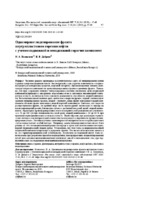| dc.contributor.author | Козначеев, И. А. | |
| dc.contributor.author | Добрего, К. В. | |
| dc.coverage.spatial | Минск | ru |
| dc.date.accessioned | 2019-02-04T06:43:06Z | |
| dc.date.available | 2019-02-04T06:43:06Z | |
| dc.date.issued | 2019 | |
| dc.identifier.citation | Козначеев, И. А. Одномерное моделирование фронта внутрипластового горения нефти с учетом подвижной и неподвижной горючих компонент = One-Dimensional Simulation of the In-Situ Oil Combustion with Consideration to Fluid and Solid Combustible Components / И. А. Козначеев, К. В. Добрего // Энергетика. Известия высших учебных заведений и энергетических объединений СНГ. – 2019. – № 1. – С. 47-60. | ru |
| dc.identifier.uri | https://rep.bntu.by/handle/data/49405 | |
| dc.description.abstract | Численно решена одномерная осесимметричная задача об инициировании волны горения в нефтенасыщенном пласте. Рассматривались две горючие компоненты – подвижная (нефть) и неподвижная (кероген, нефтяной абсорбат). Проанализировано влияние наличия двух горючих компонент на время инициирования горения и динамику фронта. Показано, что при сохранении полного теплосодержания системы увеличение доли подвижной компоненты приводит к замедлению образования очага и снижению максимальной температуры в пласте, несмотря на более высокую реакционную способность жидкой компоненты. Расчеты показывают наличие двух «всплесков» скорости фронта: первый соответствует времени инициирования горения, второй – моменту, когда фронт выгорания твердой компоненты обгоняет фронт вытеснения жидкой горючей компоненты. Отмечено, что скорости распространения фронта, по крайней мере после прохождений «всплесков» и выхода на квазистационарный режим, близки для случаев с различной массовой долей жидкой компоненты. Характерное время формирования очага экзотермической реакции может увеличиться с 50 до 200 сут при повышении массовой доли жидкой компоненты с 30 до 80 % при принятых термодинамических условиях в пласте. Таким образом, при реализации термогазового метода в высокопроизводительных пластах повышается вероятность трудности инициирования очага. Поэтому изучение закономерностей внутрипластового горения для таких случаев представляет особый интерес. Например, задача инициирования очага может быть решена за счет повышения концентрации кислорода в дутье или использования нестационарной (периодической) подачи дутья. Установлено, что учет более реакционноспособной подвижной компоненты приводит к уширению фронта. Это может положительно сказаться на его термогидродинамической устойчивости. Результаты исследований могут быть использованы при разработке проектов нефтедобычи, конструировании специализированных печей для сжигания многокомпонентных топливных смесей в неподвижном слое, при термохимических исследованиях многокомпонентных топлив. | ru |
| dc.language.iso | ru | ru |
| dc.publisher | БНТУ | ru |
| dc.title | Одномерное моделирование фронта внутрипластового горения нефти с учетом подвижной и неподвижной горючих компонент | ru |
| dc.title.alternative | One-Dimensional Simulation of the In-Situ Oil Combustion with Consideration to Fluid and Solid Combustible Components | ru |
| dc.type | Article | ru |
| dc.identifier.doi | 10.21122/1029-7448-2019-62-1-47-60 | |
| local.description.annotation | The one-dimensional axisymmetric problem of initiation of a combustion wave in an oil-saturated reservoir is solved numerically. Two combustible components, viz. liquid (oil) and solid (kerogen, oil sorbate) were considered. The influence of the abovementioned components on time of the hot site ignition and combustion front speed was simulated and analyzed. It was demonstrated that growth of the mass fraction of liquid component (the total heat content being preserved) results in retard of formation of the hot site near the well and in reduction of the maximum temperature of the combustion wave, disregarding of the higher reactivity of liquid combustible. Simulation revealed existence of the two “peaks” of thermal front velocity. The first one corresponds by time to ignition of combustion site. The second one corresponds to a moment when the solid component combustion front overrides the oil displacement front. Calculations shown, that thermal wave propagation velocity, at least after passing the “peaks” and transition to quasi-steady regime, does not considerably depend on mass traction of the fluid component in the system. A typical term of the exothermic reaction site formation may increase from 50 to 200 days in case of growth of the liquid component content from 30 to 80 mass % at the considered thermal conditions in the oil reservoir. Thus, the implementation of the thermogas method in high-productive layers increases the likelihood of difficulty of initiation of a fire. Therefore, the study of the regularities of intra-combustion in such cases is of a particular interest. For instance, the task of combustion site ignition may be resolved by increase of oxygen content in blowing-gas or by means of non-steady (periodical) blowing. It is found that taking into consideration of highly reac-tive liquid component results in widening (diffusion) of the thermal front, which may play positive role in its spatial thermo-hydrodynamic stabilization. The results of simulation may be utilized for development of technical projects of oil recovery via insitu combustion, for designing of furnaces utilizing multicomponent fixed layer fuels and for thermochemical investigation of multicomponent fuels. | ru |

